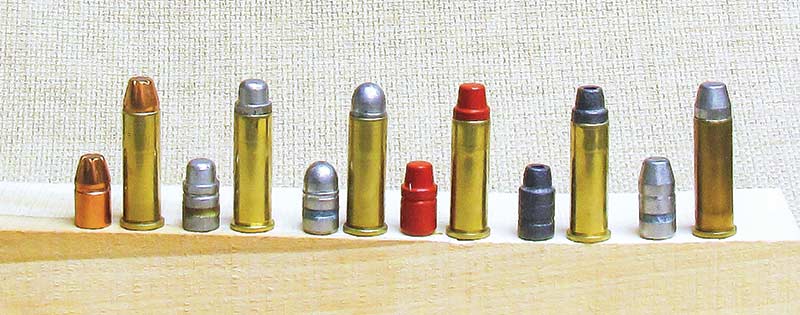THE .38 SPECIAL AND .44 SPECIAL
Special loads for special leverguns –JOHN TAFFIN
It seems everyone is always talking about .357 Magnum and .44 Magnum leverguns but what about .38 Special and .44 Special loads in leverguns which were chambered thus originally?
Hen’s Teeth
Neither of these have been easy to find, with the .38 Special much more so than a .44 Special. In fact, I have the only original .44 Special levergun I ever saw back in the 1990s, a Cimarron Uberti Model 1866. The good news is Cimarron now catalogs the 1866 in both Special chamberings and the 1873 in .44 Special. For a very short time Marlin made their 1894 Cowboy Comp in .38 Special and I have one of these also. My second .38 Special levergun started life as a 24″ octagon barreled Model 1866. It was very heavy along with its partner chambered in .45 Colt but I had both of those cut back to 16-1/4″ and now they are very handy Trapper Models.
There is much talk today of rifles’ use for home defense. Setting off a Magnum chambered rifle or a .223 in a closed room results in ear-shattering muzzle blast. We now have excellent self-defense loads in both .38 Special and .44 Special available that work well for self-defense without the excessive muzzle blast. All of my handloads for the Special leverguns are made for easy shooting and will also do just fine for small game and varmints, plastic bottles and pop cans, and definitely for paper punching, with a minimum of recoil. My “Trapper Model” is especially apropos for all of these while being very kind to the shoulder.
Loads
Assembling .38 Special and .44 Special cartridges for leverguns is pretty straightforward. Normally I use my Redding .357 Magnum and .44 Magnum dies. However, when I really wax nostalgic, I dig out my ancient .38 Special and .44 Special dies from the pre-carbide sizing era. One thing I do with both Special cartridges is load dummy rounds first to make sure they will feed through the action and chamber. The Model 1860/1866/1873 replicas are especially particular about overall cartridge length. I sometimes run .44 Colt loads through my .44 Special 1866 but they need to be very close to .44 Special length or they will jam the action.
Powders for Special loads for the Specials are those we normally use for easy shooting loads and this includes two old standbys — Bullseye and Unique from Alliant as well as their Red Dot and Hodgdon’s TiteGroup. My choice of brass is always Starline with CCI Pistol Primers. Neither the loads nor the sights on these rifles are designed for long-range shooting.
.38 Bullets
For the .38 Special my most-used loads are assembled with cast bullets. This includes the Oregon Trail 158 RNFP which feeds ever-so-smoothly through the actions of both rifles, while the Oregon Trail 180 FP works just fine when I want a heavier bullet. Speer offers a relatively soft 158-gr. LSWCHP (Lead Semi-Wadcutter Hollow Point) that works well for both sixgun and levergun .38 Special loads.
These are available quite reasonably in a 500-count bulk pack. A longtime favorite .38 bullet is the Lyman #358477, a 158-gr. bullet quite close to the original .357 Magnum bullet design. Powder coated bullets are readily available today and I like the Acme 125- and 158-gr. “Lipstick Bullets.” These are bright red bullets, powder coated instead of lubed. My friend and fellow Shootist, Dick Thompson, is also a dedicated user of PC Bullets and has supplied me with a 158-gr. SWC that also works well in the .38 Special. Jacketed bullets of choice include the Hornady 110 and 125 XTP JHPs that shoot very well and are especially apropos for varmints and small game.
.44 Bullets
Selecting .44 Special bullets is quite easy for use in the 1866 levergun as I mostly go with Oregon Trail RNFP, available in 200-, 225- and 240-gr. weights as well as sizes from 0.427″ to 0.430″, making it easy to tailor the bullet to individual sixguns or leverguns. They feed very smoothly.
Most, actually, nearly all of my shooting with these Special leverguns is done at 25 yards. The two jacketed Hornady bullets mentioned above are especially great shooting in the .38 Special Model 1866. The 110 XTP over 6.0 grains of W231 and the 125 XTP over 5.5 grains of W231 clock out at 1,400 fps and 1,240 fps respectively with three shots going into 3/4″ and 5/8″ also respectively. More than accurate enough and powerful enough for small game and varmints. Switching to cast bullets the Oregon Trail 158 RNFP over 11.0 grains of #4227 and the Acme 158 RNFP using 4.0 grains of Bullseye are both excellent performers with groups under 1″ and muzzle velocities of around 1,225 fps.
Switching to the .44 Special in the Model 1866 using the Oregon Trail bullets mentioned above results in exceptional accuracy using TiteGroup and Red Dot. Some special loads include the 200-gr. RNFP over 5.5 grains TiteGroup, 1,100 fps and the 225-gr. RNFP over 5.5 grains of Red Dot, 1,050 fps both giving virtually one-hole groups. Red Dot works especially well with the 200-gr. RNFP with groups well under 1″ with muzzle velocities of 1,150 fps.
Now replicas of the 1866 and 1873 Winchesters are more readily available, choosing these century-old cartridges not only fulfills our nostalgic bent but also gives very relaxed shooting since both cartridges in these leverguns are very friendly to new shooters.



